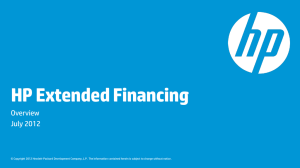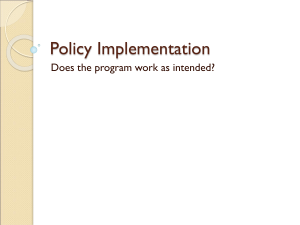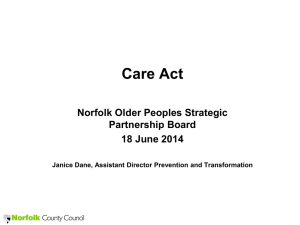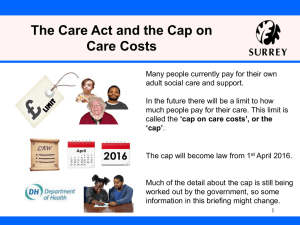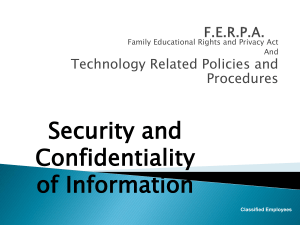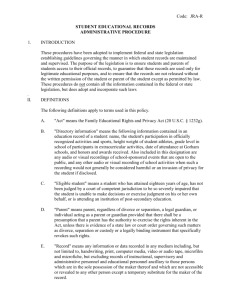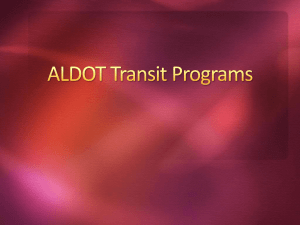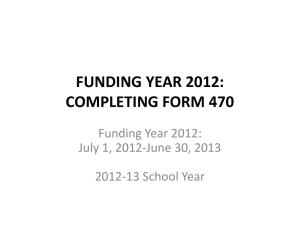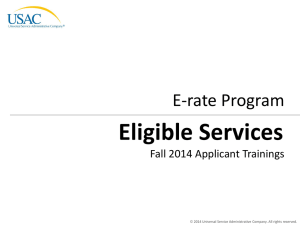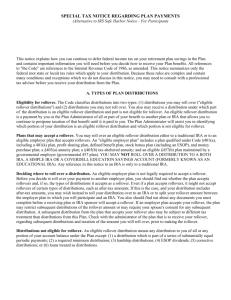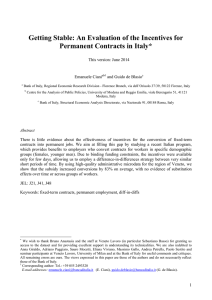E-Rate Session
advertisement
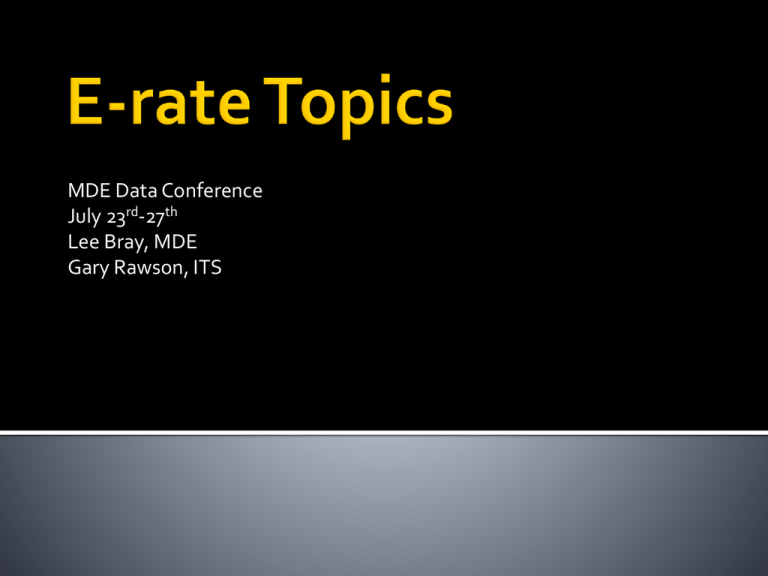
MDE Data Conference July 23rd-27th Lee Bray, MDE Gary Rawson, ITS 1. 2. 3. 4. 5. 6. Technology Plans Funding Future Basic Maintenance School/District Merging Open Discussion Year 2 Annual Review – Due September 21, 2012 2013 – 2016 Technology Plan – Start planning now Original Funding Cap Current Funding Cap Net increase of $2,250,000,000 $2,338,786,577 $ 88,786,577 Total Demand FY2012 $5.237 billion (up 21.5%) Total P1 Demand 2012 $2.444 billion (up 12.5%) Total P2 Demand 2012 $1.379 billion (90% only) Funding Year Total Demand % Change 2012 $5,236,939,650 21.5% 2011 $4,309,942,527 10.1% 2010 $3,915,889,487 -1.8% 2009 $3,986,033,329 -7.5% 2008 $4,307,572,380 16.8% Funding Year Total Demand % Change 2012 $2,444,087,363 12.5% 2011 $2,172,884,435 6.6% 2010 $2,038,141,531 -0.3% 2009 $2,043,431,050 4.5% 2008 $1,954,968,906 9.1% Funding Year Total Demand % Change 2012 $3,822,939,650 20.2% 2011 $3,180,888,705 4.6% 2010 $3,041,558,623 6.7% 2009 $2,851,562,280 -5.6% 2008 $3,021,663,857 20.7% BTOP – Broadband Technology Opportunities Program $3.5 Billion for Broadband projects Funding Year Funding Requests Total Demand Avg. $ per FRN 2012 154 $6,242,661 $40,536 2011 88 $2,731,457 $31,039 2010 10 $330,199 $33,019 What changed? Bundled VoIP Handsets. Current Funding Cap P1 Demand Remainder for P2 $2,338,786,577 $2,444,087,363 -$ 105,300,786 P2 Demand for 90% $1,378,852,287 P1 and P2 90% Demand $3,822,939,650 Rollover – April 2012 Rollover – July 2012 Total Rollover $ 400,000,000 $ 650,000,000 $1,050,000,000 Current Funding Cap Total Rollover $2,338,786,577 $1,050,000,000 Total Available for 2012 $3,388,786,577 P1 and P2 90% Demand $3,822,939,650 Difference -$ 434,153,073 Hopefully, that is close enough. As I see it the FCC has 4 options: 1. Do nothing 2. Remove funding from many services that are currently eligible 3. Alter Discount table 4. Increase the funding cap If we have another 12% increase in P1 Demand for FY 2013 we will need $2,737,377,846 We cannot always count on rollover dollars 1. Why? Where do rollover dollars come from? P2 will be a thing of the past (came close this year, didn’t it) If we have another 12% increase in P1 Demand in FY 2014 we will need $3,065,863,187 just for P1 Then what? If by FY 2014 we have a demand of $3,065,863,187 with a funding cap of $2,338,786,577, what do you think is going to happen? Proration, even for P1 services – to divide, distribute, or assess proportionately. 90% first, but will only get whatever percentage the funds will allow For example, a 90% school might only get an 85% discount, if that is what the funds allow. How will you budget for that? I don’t think we want the FCC to do nothing Eliminate P2 entirely (equipment and maintenance) Cell phones Long distance POTS Web Hosting Only pay for network connectivity and Internet Access services at the school The program saves $, but someone loses No more 90% discounts on any service. One suggestion was to lower all discounts by 5% across the board Another suggestion was to lower all discounts by 10%. The purpose is to match potential demands to available funding. Sounds like proration, doesn’t it. How is lowering the discount table different from proration? The program saves $, but someone loses Original Funding Cap Current Funding Cap Net increase of $2,250,000,000 $2,338,786,577 $ 88,786,577 (in 15 yrs) Equal Demand? $5.237 billion Then applicants below 80% will apply, increasing demand even more Is the program fair in its current form? Double Current Amt? $4,677,573,154 Where would the funds come from? Agreements or contracts must state the eligible components covered, make, model and location Basic Maintenance is a recurring service. Must be delivered within the July 1st to June 30 timeframe (cannot be extended beyond June 30th) Cannot be generic “Maintenance on eligible equipment” Cannot be for a block of hours “100 hours of maintenance at $75 per hour” Unbundled warranties are NOT eligible Unbundled warranties allow for broken equipment to be fixed or if it is beyond repair, replaced Unbundled warranties are considered a type of retainer and not as an actual maintenance service This does not apply to a manufacturer’s warranty of no more than three years that is included in the price of the equipment OR If the retainer is tied to actual service performed Operating system software, such as network operating system software required to obtain operation of an eligible component, is eligible, including functionality provided with the core operating system at no cost. Additional software products available separately that provide optional operational features are not eligible for discount. E-mail software that is a server-based, shared product is eligible. If such a software product provides substantial additional functionality that is not eligible, such as archiving, database, workflow, or groupware features, only the e-mail portion of the product is eligible and the cost of the ineligible portion must be cost allocated. The following basic maintenance services are eligible: Repair and upkeep of eligible hardware Wire and cable maintenance Basic technical support Configuration changes Annual software service agreements are not mentioned as eligible “…software Client Access Licenses are not eligible as Basic Maintenance. However, Client Access Licenses for eligible software products may be eligible in the Internal Connections funding category. “ Cisco SMARTnet Provides: Global 24 hour access to Cisco Technical Assistance Center (TAC) Access to online knowledge base, communities and tools Hardware replacement options, including 2-hour, 4-hour, and next business day Operating system software updates Smart, proactive diagnostics and real-time alerts on devices enabled with Smart Call Home The FCC determined that SMARTnet was an unbundled warranty and thus ineligible Offerings historically included in SMARTnet to be divided, for E-rate customers, into two offerings CiscoBase: BMIC services allowable as a one-time charge: Software downloads, bug fixes, etc. TAC access Web tools Does not include Advanced Hardware Replacement Cisco Time & Material process: replacement parts/physical labor Established price points for replacement parts Expect Customer to establish relationship with approved E-rate provider to implement a complete support program Transfers From a Closed Location Equipment can be transferred to other eligible entities - even if those entities are at a lower discount level - if the particular location where the service was originally received is temporarily or permanently closed. This includes equipment serving part of a facility, such as equipment serving individual classrooms, if that portion of the facility is temporarily or permanently closed. The transferring entity must notify USAC of the transfer, and both the transferring and receiving entities must maintain detailed records of the transfer and the reason for the transfer for five years from the date of the transfer. We just addressed what can be done with equipment. What about the WAN circuits, Internet, Long Distance, POTS lines, Cell Phones? We have asked for clarification and have not yet received an official answer. Unofficial answer is to upgrade circuit/services and maintain split billing. If two SPs then do a SPIN change and do split billing. You must notify USAC
